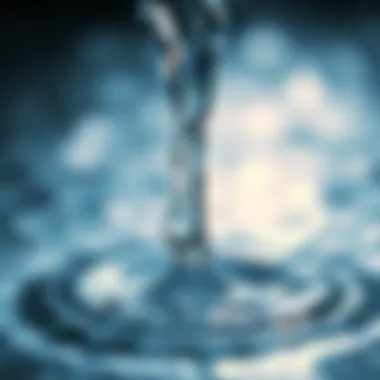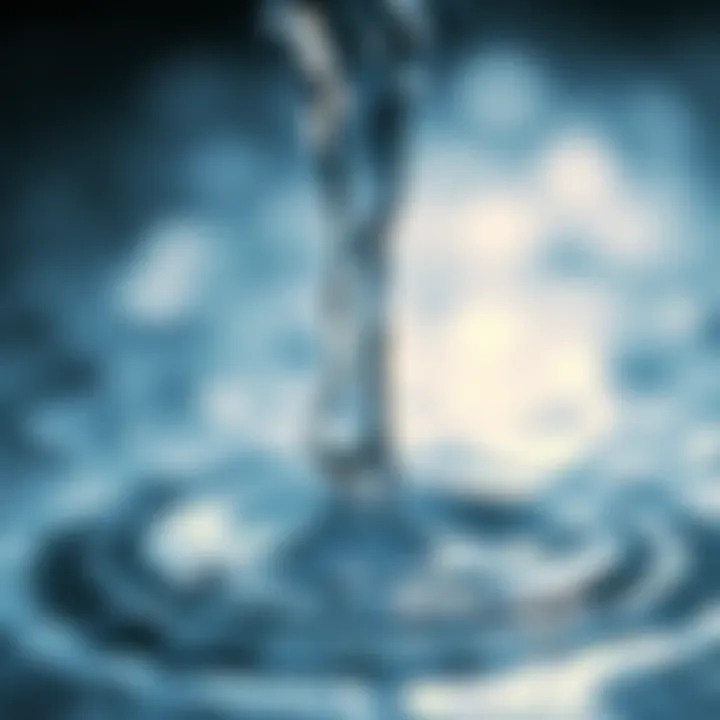Exploring Local Factors of Water Softness


Intro
Water quality stands as one of the cornerstones of public health, impacting everything from agricultural practices to household hygiene. A particular focus within this sphere is water softness, which can fluctuate markedly depending on geographic regions. Understanding the implications of varying water softness not only enhances personal choices but also informs community strategies towards water management. This exploration provides insights into the múltiple dimensions of water hardness, examining how it shapes both daily life and environmental practices.
Research Overview
Summary of Key Findings
- Geographic Variations: Water hardness levels differ vastly across regions due to geological formations. Areas with limestone or gypsum tend to have higher hardness compared to regions with igneous or metamorphic rocks, which yield softer water.
- Health Implications: Hard water can have subtle effects on skin health, while very hard water may inhibit the absorption of certain essential minerals, influencing overall well-being.
- Appliance Longevity: Higher mineral concentrations in hard water can lead to scale buildup in pipes, water heaters, and appliances, ultimately costing households in repairs and energy efficiency.
Background and Context
For many, water quality seems like a distant concern. Yet, as studies reveal, water softness plays a vital role in daily experiences. Regions with hard water must navigate issues from clogged pipes to soap scum on dishes. In contrast, softer water regions enjoy easier cleaning processes and appliance maintenance. This sharp contrast highlights the need for localized approaches to managing water resources.
Understanding water softness necessitates a closer look at its fundamental properties and the natural processes that dictate water quality.
Methodology
Experimental Design
Research on water softness encompasses both quantitative and qualitative approaches. The assessment of water hardness often begins with sampling from varying sources—municipal systems, wells, and natural springs. These samples are analyzed for their mineral content, focusing chiefly on calcium and magnesium ions, the primary contributors to water hardness.
Data Collection Techniques
- Water Sampling: Utilizing standard sampling methods ensures representative data. Samples must be collected in clean, inert containers to prevent contamination.
- Laboratory Analysis: Employing titration methods provides precise measures of hardness, while spectroscopy may give insight into other mineral compositions.
- Surveys and Studies: Engaging with local populations through surveys can uncover personal experiences and perceptions of water quality related to health and usage.
Culmination
As this article unfolds, it will take you through the intricate relationship between water softness and its local impact. Understanding this provides clarity for better personal choices and indicates necessary steps for local water management policies to enhance public health and welfare.
"Get the facts straight: Hard water isn't just a nuisance—it's a challenge to health and efficiency."
For those curious for more detailed exploration, resources from Britannica, EPA and National Ground Water Association can be invaluable.
Prelude to Water Softness
Water softness is more than just a simple scientific concept; it is an essential factor that impacts our daily lives in various, often unrecognized ways. Understanding this concept helps individuals grasp why the quality of water differs across regions, shaping our experience with household tasks, hair and skin health, and even our finances. When we talk about water softness, we're fundamentally looking into the balance of minerals dissolved in our water supply, such as calcium and magnesium, which play significant roles in determining its softness or hardness.
Defining Water Softness
At its core, water softness refers to the low concentration of calcium and magnesium ions in water. In essence, soft water contains fewer minerals and is seen as preferable in many domestic contexts. For instance, if your water is nicknamed "liquid gold" because it feels smoother against your skin and doesn't leave pesky mineral deposits on your glasses and fixtures, you've likely got soft water.
Widespread softness can occur naturally in areas with specific geological formations. If you live in a region with lots of granite or sandstone, you might enjoy softer water consistently. On the contrary, if your town is built on limestone, hard water may be the norm. It might not make much dancing in your daily life when you’re washing dishes or rinsing your hair, but it contributes significant long-term impacts to appliances and your health.
Importance of Water Quality
The quality of water directly influences several aspects of our lives. Firstly, it can affect health and wellness. Water softeners may protect household plumbing by preventing scale buildup, which accumulates when hard minerals precipitate out in water-heated environments. Less buildup means lower maintenance costs down the road. Furthermore, soft water is often gentler on skin and hair—an essential consideration for those with sensitivities or allergies to harsh minerals.
The implications of water quality extend beyond individual households; they reach into broader community concerns. Areas with hard water might incur higher expenses related to water treatment facilities and infrastructure maintenance. In the long run, understanding water quality isn't merely an academic pursuit—it's a practical, actionable knowledge that can help communities make informed choices about local water management practices.
"Water isn’t just a resource; it’s a lifeblood of communities. Knowing its quality helps secure a healthy future."
In summary, recognizing water softness and its significance enhances our understanding of regional water supplies. It stresses the importance of considering local contexts when discussing water quality—a multifaceted issue that has undeniable repercussions on daily life.
Geographic Variations in Water Hardness


Understanding the geographic variations in water hardness is essential because it allows us to recognize how different locations experience unique challenges related to water quality. Regions across the globe can have varied mineral compositions, affecting not just the taste and clarity of water, but also its overall safety for consumption, use in household appliances, and its environmental implications. This section will delve into how these different factors contribute to varying water hardness and the significant effects they have on local communities.
Regional Differences
Water hardness is not evenly distributed; it varies widely across regions. For instance, areas like Detroit, Michigan, tend to have softer water due to their abundance of Lake Michigan's natural resources. In contrast, cities in the American Southwest face much harder water stemming from local geological factors. Understanding these regional differences helps in customizing water treatment approaches. Consumers, for example, can tailor their use of soaps and other household items based on local water hardness conditions, potentially avoiding unnecessary costs and frustrations.
Natural Factors Influencing Hardness
Geology and Mineral Content
The geology of a region is perhaps the most significant contributor to its water hardness. Regions with limestone and chalk are likely to have higher concentrations of calcium and magnesium. This means that when rainwater seeps into the ground, it dissolves these minerals, leading to harder water. The key characteristic of this aspect is that it provides a natural filtration mechanism, which contributes beneficial minerals to the water.
However, this also poses challenges. High hardness levels can lead to scaling in plumbing systems, reduced efficiency in water heaters, and even spoilage of cooking ingredients. Thus, though local geology is a toughnut when considering water quality, it also necessitates attention to proper management practices to mitigate potential downfalls.
Climate Conditions
Climate significantly molds water hardness through rainfall patterns and evaporation rates. For instance, arid regions tend to have naturally higher levels of dissolved minerals because less rainfall means minerals remain in the ground and get concentrated over time. Conversely, areas with ample rainfall often experience softer water since the heavy rains can wash away accumulated minerals. The unique feature of this phenomenon is that it can influence seasonal water hardness differences, complicating water management strategies throughout the year.
However, it’s a double-edged sword since changing climate patterns may affect these established conditions. Areas traditionally seen as vulnerable to hard water might shift, requiring a reconsideration of resource allocation and local water policies.
Human Impact on Water Composition
Industrial Discharges
The impact of industry cannot be overlooked when discussing water hardness. Factories often release treated and untreated discharges into local water bodies, altering both the chemical makeup and hardness of water. Commonly, industrial operations introduce heavy metals and other chemicals that can complicate local ecosystems. Understanding this distinctive characteristic is crucial, especially when considering regulations around industrial wastewater. While you might gain economically from industrial activities, they often leave communities with a tougher time managing harder water loads than expected.
This point emphasizes the necessity for stricter control measures to ensure that water remains safe for both ecosystem health and human consumption. Not only can poorly managed discharges worsen water quality, but they can also lead to public health crises, as communities may unknowingly consume contaminated water.
Agricultural Runoff
Agricultural runoff is another major player in altering local water quality. With pesticides, fertilizers, and sediment running off fields after rains, the resulting contamination can drive hardness levels up in nearby water systems. The key characteristic of agricultural runoff is that it often carries a cocktail of chemicals detrimental to water health.
This issue highlights the unique challenge agriculture poses. Farmers may be well-intentioned, applying necessary nutrients to promote growth, but runoff creates unintended consequences. A sustainable approach that measures the trade-off between agricultural productivity and environmental health is critical for balancing these demands.
"The management of water resources in agricultural areas must consider the dual aims of promoting agricultural yields and preserving natural water quality."
In summary, the geographic variations in water hardness shape how communities interact with and respond to their water needs. By understanding the underlying natural and human factors at play, we can better appreciate the complexity of our water systems and strive for solutions that suit our unique local contexts.
Assessment of Water Hardness
Assessing water hardness is critical for understanding the quality of water in any given region. It serves as the bridge connecting various elements such as household usage, health, and environmental wellbeing. Engaging in accurate assessment allows communities to tackle specific water-related issues effectively and develop localized strategies to manage water quality. Moreover, the implications of hardness on appliances and plumbing underscore the practical necessity of routine evaluations, ensuring that residents are well-informed about the water they consume.
Reliable assessment methods lend credibility to findings and pave the way for informed decisions regarding water treatment practices, which can lead to better outcomes for both health and economics.
Methods of Measurement
When it comes to measuring water hardness, two prominent methods stand out: titration techniques and electronic meters. Both have their merits and drawbacks, making them useful in different scenarios.
Titration Techniques
Titration is a classic method for determining water hardness, relying on chemical reactions to measure ion concentration. One key characteristic of titration is its ability to provide precise measurements, especially valuable in a scientific context where accuracy is paramount. This method involves adding a reagent to a water sample until a specific chemical reaction occurs, signaling that the hardness level has been reached.
The benefit of using titration is its reliability. It does not require advanced technology, making it accessible for laboratories and home settings alike. However, it is essential to note that titration can be time-consuming and may require a level of expertise to interpret results accurately. In this article, titration is highlighted not just for its precision but also for its straightforwardness in establishing a baseline for water quality assessments.
Electronic Meters
Electronic meters offer a modern approach to measuring water hardness, typically providing quick results. These devices operate by passing an electric current through water samples, determining hardness based on conductivity. One notable advantage of electronic meters is their user-friendliness; they are often equipped with digital displays for immediate readings, making them an attractive choice for non-experts.


However, while they offer convenience and speed, electronic meters can have drawbacks. They may require calibration to maintain accuracy and can be influenced by other water properties, such as temperature. This method is particularly useful in assessing large volumes of water quickly, a major plus for municipalities managing extensive water systems. Given their ease of use, electronic meters are effectively discussed here as valuable tools amidst the modern approach to water management.
Interpreting Hardness Levels
Understanding water hardness doesn't stop at measurement; interpreting the levels is equally important. Classifying water into distinct categories based on hardness can significantly influence daily living conditions.
Soft Water
Soft water is often celebrated for its beneficial characteristics, especially when it comes to personal care and household tasks. One of its key attributes is the low concentration of calcium and magnesium ions, making it gentler on skin and hair. Environments with soft water typically see less scale buildup in plumbing, reducing the wear on appliances and improving longevity.
Historically, areas with soft water have been associated with fewer health issues related to personal hygiene and overall comfort. However, it’s crucial to mention that very soft water may lack certain minerals that contribute to a balanced diet, leading to questions about long-term health implications. In this context, the dual nature of soft water highlights significant benefits while also necessitating continued scrutiny of dietary mineral intake.
Hard Water Categories
On the other hand, hard water is categorized based on its mineral content—slightly hard, moderately hard, and very hard. One prominent feature of hard water is its higher concentration of calcium and magnesium, which can pose challenges in everyday life. Hard water can lead to the formation of scale, which clogs plumbing fixtures and diminishes appliance efficiency. Interestingly, certain studies have suggested that regions with moderate hard water might benefit from cardiovascular health implications, creating a nuanced view of its impact.
Despite these potential benefits, hard water presents undeniable challenges, often necessitating water treatment solutions that increase household costs. A nuanced classification of hard water therefore underscores the value of localized assessment approaches in adapting solutions tailored specifically to community needs.
Implications of Water Softness
Understanding the implications of water softness is crucial as it affects various aspects of daily life and local environments. Water softness doesn't merely refer to the feel of water but encompasses a whole spectrum of influences that range from household functionality to economic factors. As one delves deeper into this topic, several specific elements stand out, including health considerations, appliance longevity, and financial impacts.
Effects on Household and Health
Appliances and Plumbing
Water hardness has a significant impact on household appliances and plumbing systems. Hard water can lead to the buildup of scale, which often coats heat-exchange surfaces, such as those in water heaters. This accumulation can lead to decreased efficiency, which in turn raises energy costs. Over time, the durability of appliances like dishwashers and washing machines is compromised, leading to more frequent replacements. It’s essential to acknowledge that the characteristics of softened water can extend the lifespan of these appliances, reducing the need for costly repairs and replacements. Additionally, soft water also requires less detergent for effective cleaning, making it a practical choice for many households. However, it is important to note that the initial costs associated with water softening systems might deter some homeowners.
Personal Care and Skin
Beyond appliances, the softness of water also plays a role in personal care and skin health. Soft water tends to be gentler on the skin compared to hard water, which can cause dryness and irritation. Many individuals find that their skin feels better and their hair is softer after using softened water. The key characteristic here is that soft water allows for better lathering and adsorption of soaps and skincare products, optimizing their effectiveness. This can make a profound difference for those with sensitive skin or conditions such as eczema. However, the downside could be the potential for an increased dependency on certain types of soap and skin care products, as some may not perform as well in hard water.
Economic Considerations
The economic implications of water softness are not to be overlooked. The costs associated with water treatment can vary, impacting families and communities alike.
Cost of Water Treatment
The financial burden of treating hard water is a notable concern. Households often spend considerable amounts on water softening systems, which can involve upfront installation costs, as well as ongoing maintenance expenses. Despite this, the long-term benefits often outweigh the initial investments. Cleaner appliances, lower energy bills, and longer-lasting plumbing systems mean that over time, these costs can be offset significantly. Moreover, local governments may find that investing in community water treatment programs can lead to overall savings at the municipal level.
Long-term Infrastructure Maintenance
Long-term infrastructure maintenance is another crucial aspect tied closely to water softness. Hard water can accelerate the deterioration of pipes and plumbing systems. This makes regular maintenance not just a good practice but a necessity, which can lead to increased governmental expenditure. Communities with softer water may enjoy prolonged infrastructure longevity, resulting in reduced costs for repairs and replacements in the long term. Local authorities should consider these implications as part of their water management strategies, recognizing that the investment in softening initiatives may ultimately save money and enhance the community's quality of life.
"Understanding water softness is not merely an academic endeavor but a practical necessity that influences health and economic viability daily."
By examining these implications, it becomes evident that water softness is a multifaceted issue with genuine consequences for populations. Whether through health benefits, appliance longevity, or economic efficiencies, the topic warrants a closer look in every local context.
Solutions for Hard Water Issues
Hard water can create a cascade of challenges for individuals and communities, ranging from scaling on appliances to adverse effects on skin and hair. Understanding solutions for hard water issues is paramount, not just for household comfort but also for long-term health and economic considerations. Various methods and techniques exist that promise to tackle the quandaries posed by hardness, offering pathways toward softer, more manageable water. This section discusses some notable solutions and sheds light on their applicability in local contexts.
Water Softening Techniques
Water softening techniques are critical for communities grappling with hard water. Different methods vary in their approaches, costs, and feasibility, which influence their adoption and effectiveness.
Ion Exchange Systems


One predominant water softening technique is the ion exchange system. This method utilizes a resin containing sodium ions that replace calcium and magnesium ions in the water, effectively reducing hardness levels. A key characteristic of ion exchange systems is their reliance on a continuous flow process that ensures water remains soft as it circulates through the household. Their popularity can be attributed to their straightforward installation and efficient operation.
However, they do have a unique feature — the need for periodic salt replenishment. This feature is essential for maintaining the system's efficacy, particularly in areas with particularly hard water. While ion exchange systems yield significant advantages, such as reducing scale buildup and enhancing the lifespan of plumbing fixtures, they also have disadvantages, including ongoing maintenance costs and the need for water-use adjustments to manage sodium levels in softened water.
Reverse Osmosis
Another noteworthy water treatment method is reverse osmosis. This process forces water through a semipermeable membrane, effectively filtering out impurities, including hardness ions. A significant characteristic of reverse osmosis is its ability to remove not only hardness but also a wide array of contaminants from drinking water, making it a popular choice for households concerned about overall water quality.
The unique feature of reverse osmosis is its dual capability to improve water taste and purity. Nonetheless, it may have disadvantages such as wastefulness; the process tends to generate a significant amount of wastewater. Additionally, its installation and maintenance can be more complex compared to other methods. The benefits of obtaining high-quality water often outweigh the costs, particularly in areas where water contaminants are a pressing concern.
Limitations of Softening Methods
Although these softening methods can mitigate the issues associated with hard water, it's essential to recognize their limitations. Each approach may not be suitable for every household or community, depending on various factors, including water usage patterns, budget constraints, and local regulations. For instance, ion exchange systems may not be feasible in areas where environmental regulations limit sodium discharge, while reverse osmosis systems may be overkill for someone seeking minor hard water adjustments.
- Initial Costs: The installation costs for these systems can be steep, which may deter some from investing.
- Maintenance Requirements: Regular maintenance is necessary to ensure optimal performance.
- Water Waste: Particularly with reverse osmosis, the amount of waste produced can be considerable, raising concerns about sustainability.
In the realm of addressing hard water, understanding these methods and their limitations becomes essential for making informed choices.
"Solving hard water issues is not merely about making choices; it's about understanding the implications and consequences of those choices in the local water context."
Through insightful consideration of the advantages and disadvantages of each approach, communities can craft tailored solutions to serve local needs better. This consideration fosters a broader conversation about sustainable water practices that can be adopted in various regions.
Case Studies: Local Water Softness
Exploring local water softness through case studies is essential for understanding the practical implications of water hardness. Case studies represent localized assessments and provide interesting insights beyond the theoretical aspects of water chemistry. They serve as a critical framework for understanding how different regions face unique challenges concerning water quality. When analyzing specific communities, one can see the real-world consequences of water hardness on daily life, infrastructure, and even health outcomes.
Comparative Analysis of Regions
When different regions are compared, striking contrasts in water softness and hardness often emerge. For instance, in areas with abundant limestone deposits, such as the Midwestern United States, the water tends to be much harder due to higher concentrations of calcium and magnesium ions. This has a tangible impact on both household maintenance and public health. The presence of minerals can lead to significant scaling in pipes and appliances, necessitating costly repairs.
On the opposite side, locales like Florida generally have softer water due to different geological formations that do not contribute the same mineral content. A comparative analysis shows how residents in Florida might experience fewer plumbing issues and lower expenses regarding water heaters and dishwashers compared to their counterparts in the Midwest. Understanding these regional differences can help inform policies and practices tailored to local conditions, ultimately leading to more effective water management.
Additionally, the geographical context affects community perception and adaptations to water challenges. In regions with significant water hardness, citizens might frequent stores for special cleaning products or invest in home water softeners, leading to diverging economic behaviors.
Community Responses to Water Quality
The responses from communities facing hard water issues can be quite telling. When a local community in California noticed heightened complaints regarding skin irritation and appliance failures due to water hardness, they took action. Community forums were established to study the issue collectively. This led to the implementation of educational campaigns about water quality and its effects on health and property.
Community-based solutions often leverage local knowledge and experiences. Residents of a town in Texas, known for its notorious hard water, banded together to fund a pilot program assessing the effectiveness of adopting advanced filtration systems at municipal water treatment plants.
"The problems we face can sometimes feel like climbing a mountain, but together, we can find pathways to smoother waters."
By understanding regional water quality thoroughly, communities not only reactively address issues as they arise but also proactively implement systems that contribute to long-term improvements in water quality.
Culmination
Understanding water softness is not just a matter of scientific curiosity; it's a necessity that resonates deeply within our local contexts. As explored in this article, the nuances of water quality can significantly affect our health, the longevity of our appliances, and even our economic choices. Taking time to learn about this subject empowers individuals and communities to make informed decisions that could lead to better water management practices.
The Importance of Awareness
Awareness regarding the characteristics of local water sources, especially the softness or hardness, plays a crucial role in enhancing public health and environmental sustainability. When communities actively engage in dialogue about their water quality, it can lead to increased advocacy for improvements and more robust management strategies.
- Health: Understanding the implications of hard water—such as potential skin irritations or its effect on personal hygiene products—can encourage residents to seek solutions or adopt preventative measures.
- Economic Impact: Individuals educated about the costs associated with hard water can take proactive steps to mitigate expenses linked to plumbing repairs or appliance replacements. This knowledge may foster the implementation of community-wide water treatment initiatives that could save residents money in the long term.
"A little knowledge is a dangerous thing, but a little more knowledge can lead to transformative changes."
Therefore, being informed about water softness not only uplifts individual quality of life but can also ripple through the community in terms of broader environmental consciousness and economic stability.
Future Directions in Water Management
As we look ahead, the management of water softness can be improved through several promising avenues. Increasingly, technology is paving the way for innovative solutions that address local water issues. Here are a few future directions that communities and policymakers might consider:
- Smart Water Management Systems: Integrating real-time monitoring systems can help in assessing water quality dynamically, enabling quicker responses to any changes.
- Community Education Programs: Enhancing awareness through workshops and public forums could galvanize community support for water quality initiatives.
- Sustainable Practices: Promoting rainwater harvesting or water recycling methods can not only lessen dependence on local sources but also ensure a more sustainable approach to managing water softness.







